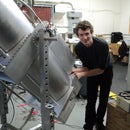Introduction: Microwave Science Experiments - Will It Blow Up? What Can We Stick In? Microwave Night at MITERS
MITERS is a creative heaven for MIT inventor types and practical physicists. We have build parties every Friday at 7 in N52-115, and anyone is welcome to come check it out and build something.
This build party, we got an old junky microwave from a thrift store, and put any interesting thing into it, before stripping it of its transformers and turning it into a welder.
Our microwave doesn't have a turntable, but it does have an impeller, which is a piece of metal outside the oven chamber that spins and changes the magnetic resonance of the box to keep standing waves from forming.
Picturing that, or at least keeping it in mind, will give you a clearer idea of why the grapes arc inconsistently, why the lightbulbs don't stay on, etc.
Photos and videos, courtesy of Jordi Castell, posted here so you can hold your own Microwave-It night!
You can also see the original photo/images at http://evalu29.uv.es/~jordi/build_party/
Step 1: Grapes
So, when you cut a grape in half (almost, but not quite fully sliced), they're about the same length as a half-wave of 2.4GHz radiation (which are microwaves).
That means that when you put them in a microwave, they resonate and the energy builds up until the juice boils and creates an ionized gas, and then arcs across the two halves.
We tried it with blueberries too, as they're almost the same size. It did work, but not quite as well.
They don't taste very good afterwards.
Here's what plasma physics on grapes looks like:
Step 2: Light Bulbs
If you put metal in a microwave, the metal will arc and spark. We just want to see if we can make these lightbulbs turn on, so we hide the metal in water, in a crystal chalice, which solves the arcing and sparking problem. (plastic would work just as well).
The lightbulbs have a cool repeating pattern, thanks to the impeller. If you took the impeller out, or had a turntable microwave and removed the turntable, you would get constant light from the bulbs, and could use them as an energy/node detector to find the strong and weak points of the field. From here you can clearly see why your food only thaws/cooks in some spots, and not others.
I like the lighthouse-like effect a lot.
Step 3: Neon Bulbs
We threw in little neon bulbs, too.
The glass of water is sort of like a resistor, preventing the bulb from blowing out by absorbing some power.
Or at least, that was the theory.
Step 4: Ivory Soap
What's so special about Ivory Soap?
What the heck does a bar of soap do when you put in in a microwave?
It's inexplicable, until you watch Alien, and then everything comes clear.
Step 5: CDs
Ah, an old standard.
Here's a cool view:













